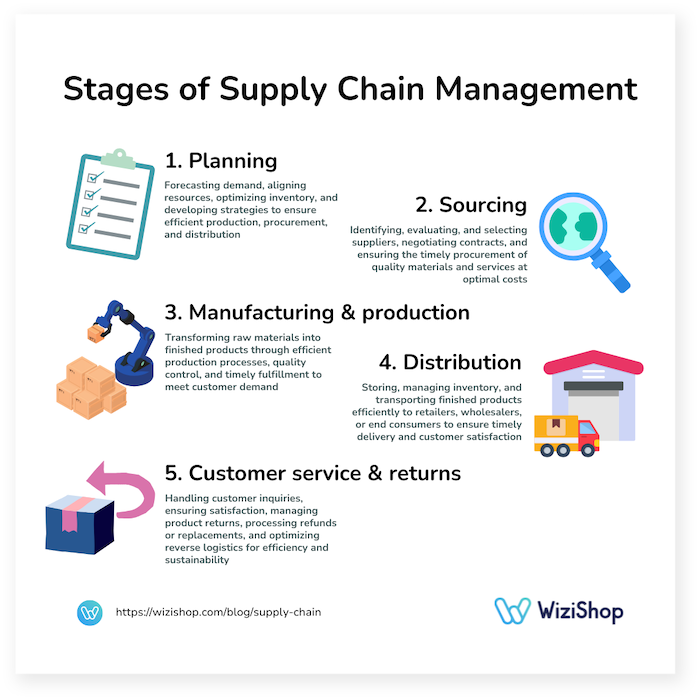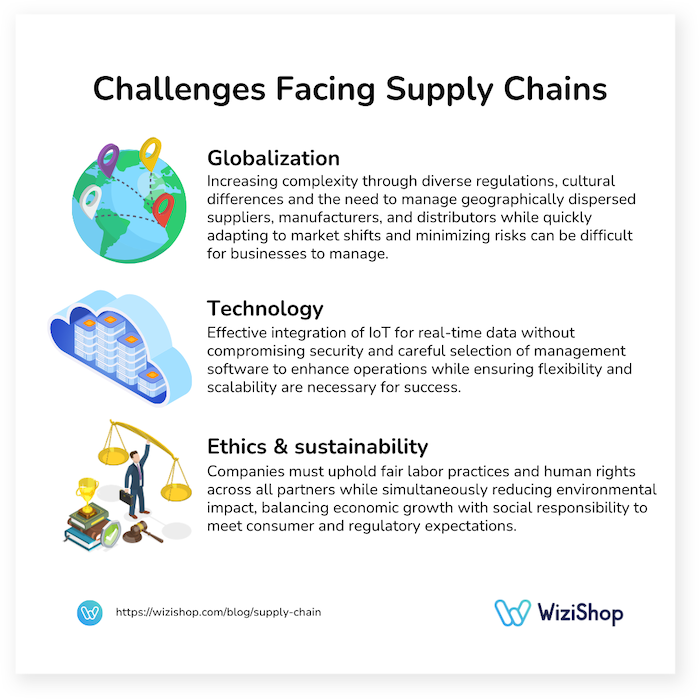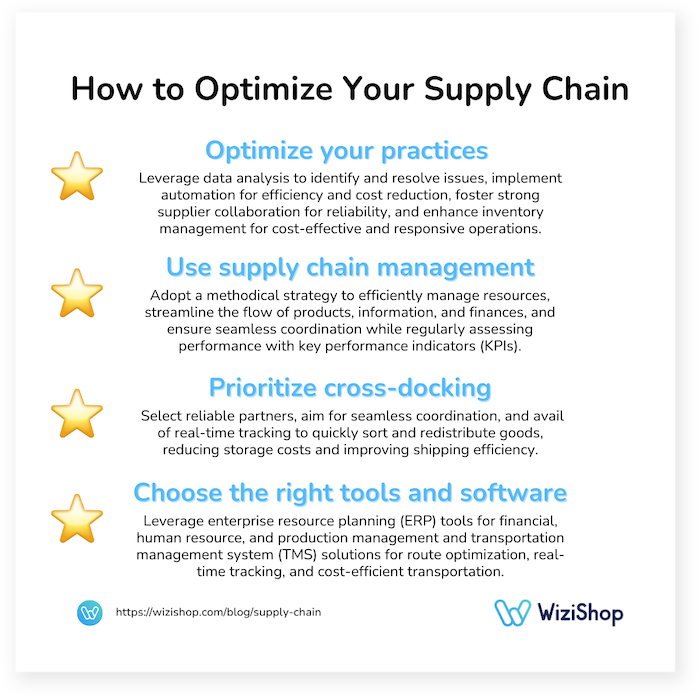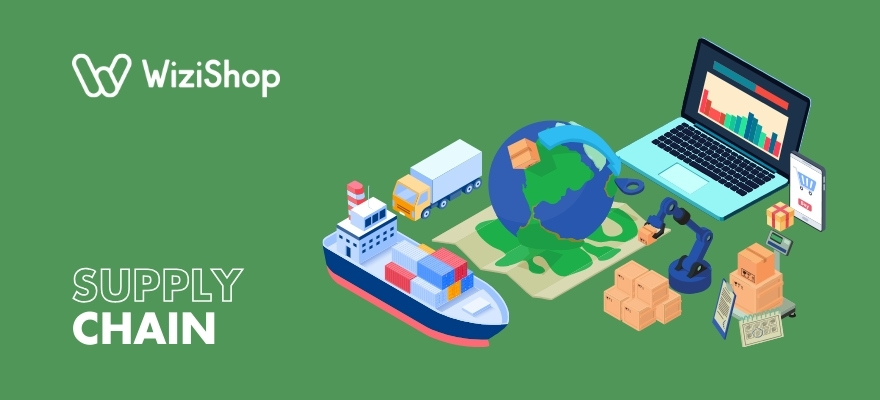Speed, fluidity, real-time tracking, customized delivery... With today’s challenges, ecommerce companies are striving to deliver the right product, to the right place, at the right moment, and at the right cost. But all this requires a kind of perfectly programmed mechanism of products, information, and finances.
In this context, the supply chain is no longer merely a technical element in the background but becomes the beating heart of any business!
Table of contents
- Supply chain definition and characteristics
- What are the different stages of supply chain management?
- Who are the players involved in the supply chain?
- What are the different flows in a supply chain?
- What are the levels of the supply chain in a company?
- What are the challenges facing supply chains today?
- How do you optimize your supply chain?
Supply chain definition and characteristics
A supply chain encompasses a number of activities whose role is to plan, coordinate, and control the flow of products, information, and finances. Its mission extends from the initial supplier’s warehouse to the end customer.

Supply chain: What is it and what does the term mean?
Supply chain is a term used to describe the entire process that takes place between the designing of an article and it getting delivered to the end consumer.
Originally, it was a concept closely linked to production and inventory management. Today, supply chain is a more inclusive concept, encompassing production, purchasing, transporting, stock, and distribution activities.
What role does the supply chain play in ecommerce?
The advent of ecommerce has radically transformed the way goods are marketed, purchased and delivered around the world. In this context, the supply chain plays a central role in a number of areas:
- Inventory management: Well thought-out inventory management is essential to meeting consumer demands in real time. The aim is to avoid stock-outs or costly overstocking.
- Logistics: Ecommerce requires fast, reliable e-logistics. Distribution centers must be optimized to handle a wide variety of orders as quickly as possible.
- Shipping: Customers expect fast deliveries. The supply chain must therefore guarantee efficient, timely deliveries.
- Returns: With the increase in online purchases, returns management has become a crucial element of buyer satisfaction.
- Supplier relations: Close collaboration with those supplying materials and/or goods is essential to guarantee item availability and to react promptly to fluctuations in demand.
- Costs: An efficient supply chain helps to reduce operating expenses, improve margins, and offer better prices to customers.
What’s the difference between logistics and supply chain management (SCM)?
The distinction between logistics and SCM is often a source of confusion, as the two fields are closely linked. However, when we look in more detail at their functions and scope, differences become apparent.
Logistics encompasses activities such as transportation, warehousing, handling, packaging, order processing, and stock management. It’s essentially concerned with the movement and storage of goods.
Supply chain management on the other hand, goes beyond simple logistics. It’s more general and covers all stages of the commercial process, from acquiring materials through manufacturing to getting the finished product to the consumer.
In other words, SCM covers a wider range of activities, including supplier relationship management, production planning, returns, supply and order management, fulfillment, and even after-sales service. Its role is to coordinate the entire procedure, while ensuring that each link in the chain works in harmony with the others.
What are the different stages of supply chain management?
SCM consists of several essential stages that ensure the smooth flow of goods, services, and information from raw materials to the final customer. Here are the main stages:

1. Planning
The first stage in the supply chain process is all about strategy and precision. It involves forecasting demand, sourcing materials, optimizing stock levels, and coordinating logistics to ensure that items reach customers efficiently.
Retailers analyze data, assess risks, and fine-tune operations to balance cost, speed, and reliability. This stage sets the foundation for smooth execution, helping companies stay agile, minimize disruptions, and meet consumer expectations while maximizing profitability.
2. Sourcing (procurement)
This stage is where businesses find the right suppliers to provide quality materials at the best price. It’s all about negotiations, contracts, and building strong vendor relationships.
Companies evaluate each potential supplier based on cost, reliability, sustainability, and efficiency to ensure a steady flow of goods. This part of supply chains directly impacts the quality of goods, costs, and overall supply chain success.
3. Manufacturing & production
Next, raw materials transform into finished products. This procedure involves assembling, refining, and quality-checking goods to ensure they meet standards before reaching customers.
Being efficient is a must— the company will focus on optimizing workflows, minimizing waste, and maintaining production schedules. Whether it’s a high-tech factory or a hands-on assembly line, this stage turns ideas into reality.
4. Distribution
The distribution stage is where goods hit the road—literally! It entails storing, packaging, and transporting goods to retailers, warehouses, or directly to customers.
Logistics teams coordinate shipments, optimize delivery routes, and track inventory to guarantee fast, cost-effective, and reliable fulfillment. Whether by truck, plane, or ship, the goal is to get products where they need to be, when they need to be there.
5. Customer service & returns
The final stage revolves around keeping customers happy and handling the unexpected. It involves assisting with inquiries, resolving issues, and managing returns or exchanges efficiently.
A smooth returns procedure builds trust and loyalty, while strong support ensures buyer satisfaction. Companies use feedback from this stage to make informed decisions and improve their offerings and operations.
Each stage plays a crucial role in ensuring that the supply chain operates efficiently, cost-effectively, and sustainably while meeting buyer expectations.
Who are the players involved in the supply chain?
Several entities are involved at different stages of the supply chain process.

Suppliers
Suppliers play a major role not only in the supply of materials, components, or semi-finished goods but also in the quality and availability of items entering the production process. Their performance is often assessed using a specific management tool, integrated into supply chain systems.
These systems enable the tracking and analysis of relevant information, such as shipping times, product conformity, etc. In this way, the supplier’s place in the production ecosystem is not only strategic but also closely linked to the overall performance of the production system.
Manufacturers
Manufacturers transform materials or semi-finished products into finished products. This can involve various tasks such as assembly, molding, cutting, etc. The performance of these operations is often measured using various indicators, which are tracked using integrated information systems.
The logistics department is also a major element in this chain, ensuring the efficient movement of raw materials to production sites and finished goods to distribution points. Manufacturers therefore play a strategic role in this organization, acting as the link between those supplying raw materials and distribution channels. Their role is not just limited to production but also extends to coordination with other logistics players to ensure a smooth and efficient supply chain.
Distributors
Distributors play a crucial role as intermediate links in the supply chain. They buy finished products in large quantities and store them in their warehouses, which are often equipped with an advanced stock management system. This tool enables the manager to monitor the quantity and location of goods in real time, optimizing warehouse space and improving the speed of service.
In addition to warehouse management, distributors also offer various services to retailers and, in some cases, to consumers.
Retailers
Retailers buy goods from distributors or manufacturers and sell them to consumers. They may be present in physical locations (stores, supermarkets) or online (e-tailers). They’re the direct point of contact with the end buyer.
Customers
Customers, whether individual consumers or businesses, are the final link in the product chain. Their demands influence the entire supply chain, both in terms of the quantity of items to be manufactured and the speed of execution and shipping processes.
What are the different flows in a supply chain?
The supply chain is a dynamic network, involving various simultaneous flows. The aim is to ensure more efficient production, warehousing and distribution of products. These flows are generally classified into three main categories: physical flows, information flows, and financial and administrative flows.

Physical flows
- Merchandise
Merchandise flows refer to the movement and coordination of raw materials, components, and semi-finished and finished goods through the supply chain. The synchronization of all these elements is essential to meet market demand, while minimizing the costs associated with production and distribution.
- Transportation and storage
The supply chain also focuses on the movement of goods from one point to another and their temporary storage in warehouses or distribution centers. Efficient management of this flow guarantees item availability, while minimizing logistics costs.
Information flows
- Big data
With the rise of new technologies, significant quantities of information are generated at every stage of the supply chain. This information provides valuable indicators for monitoring the performance of every link in the supply chain, while also analyzing trends and consumer preferences. Using big data helps companies to better anticipate demand, improve processes, and optimize their supply chain.
- Data management
All stakeholders must have access to information concerning the collection, storage, and distribution of goods. This is an essential prerequisite for making accurate, profitable decisions at every stage of the supply chain.
Financial and administrative flows
- Financial transactions
These flows concern the movement of money through the supply chain, i.e., supplier payments, credits, sales revenues, etc. Good management of these financial flows is crucial to the company’s financial health, and to enabling it to maintain stable relationships with its business partners.
- Administrative documents
This covers all the documents needed to ensure smooth procurement management, such as purchase orders, invoices, shipping documents and contracts. Managing and monitoring these elements guarantees efficiency, as well as legal compliance.
What are the levels of the supply chain in a company?
The supply chain is more than just the movement of goods from point A to point B. It also involves a complex series of decisions, strategies, and operations that need to be coordinated at different levels of the company.

Strategic level: The first central levers
At the highest level, strategic decisions shape the global vision of the supply chain. It’s about defining how the company will meet demand over the long term. This includes, among other things, product design, identifying the most promising market segments, and determining the company’s production capacities.
At this stage of the supply chain, discussions need to be held with supplier partners, distribution partners, and all other stakeholders to establish agreements on prices, shipping times, etc. The stakes are high: successful negotiations can lead to lower costs, better product quality, and more competitive pricing.
Tactical level: Between purchasing, finance, and forecasting
Tactical decisions concern the medium term and focus on optimizing resources to meet expected demand. Based on historical data and current trends, companies can establish a sales forecast. This is how they plan their production and estimate their resource needs.
This allows them to better coordinate with their supplier partners, to ensure that the necessary raw materials are available. Good planning serves to guarantee better use of resources, good cost control, and perfect satisfaction of consumer demand.
Operational level: Solutions and order management
Here, the focus is on the day-to-day operations that facilitate the effective movement of goods. This encompasses a wide range of parameters, from order taking to shipping, including preparation, packaging, transport and tracking of shipments. Here again, the aim is to ensure end-customer satisfaction, reducing shipping delays and optimizing the use of resources.
What are the challenges facing supply chains today?
With the rapid evolution of technology, the emergence of new markets and the focus on sustainability, today’s supply chains face a unique set of challenges.

These challenges, if not addressed proactively with the right solutions, can hamper business growth. In contrast, companies that tackle them strategically can also gain serious competitive advantages...
Globalization: The challenge of international expansion
With the evolution of global markets, retailers must navigate an increasingly complex economic landscape, encompassing diverse regulations and cultures. Their challenge: to quickly adapt to shifts and changes, minimize the risks associated with international markets, and maximize opportunities.
Note also that managing suppliers, manufacturers, and distributors located around the world adds another layer of complexity to all of this.
Technology: Optimizing digital services
Internet of things (IOT)
Connected devices now enable real-time data collection on the location, condition, and efficiency of supply chain elements. The challenge is to integrate IoT effectively to leverage its advantages without compromising information security.
Management software (ERP, TMS)
New digital tools are also emerging to help businesses better plan, execute, and manage their supply chain operations. To remain competitive, it’s essential to select the right tools while maintaining flexibility and scalability.
Ethics & sustainability: Strategic priorities
People’s integrity
Companies must operate in an increasingly competitive world while ensuring that workers’ rights are fully respected at every level of the cupply chain. However, this applies to all links in the chain… It’s also crucial to ensure that suppliers and partners uphold ethical standards, avoiding issues such as child labor, abusive working conditions, or unfair wages.
Environmental impact
A key mission for any company—one that is no less important—is to consider its environmental impact, reducing its carbon footprint, minimizing waste, and using resources more responsibly. The goal is to reconcile economic growth with environmental responsibility while meeting the growing expectations of consumers and regulators regarding sustainability.
How do you optimize your supply chain?
Optimizing your supply chain can lead to reduced costs, improved efficiency, and greater shopper satisfaction. It’s, therefore, a major challenge for any company. To help you enhance your performance in this area, here are some important recommendations.

Optimize your practices
- Data analysis: By examining every aspect of your supply chain with advanced analytics, you can identify issues and anomalies, allowing you to resolve them effectively.
- Automation: This is a powerful tool to improve accuracy, speed up processes, and reduce costs.
- Collaboration with suppliers: Establishing strong partnerships and maintaining transparent communication with your suppliers helps save time, improve anticipation, and enhance the reliability of the entire process.
- Inventory management: Efficient ecommerce stock management reduces inventory expenses while ensuring a more responsive approach to demand.
Use supply chain management (SCM)
We also strongly recommend adopting a methodical approach and developing a well-structured strategy to efficiently manage your resources and timelines. One of the main objectives of SCM is to optimize the flow of products, information, and finances to minimize costs while ensuring the right goods are delivered to the right place at the right moment.
To achieve this, ensure seamless coordination and regularly assess the efficiency of your supply chain using key performance indicators (KPIs).
Prioritize cross-docking
Cross-docking is a logistical practice that involves receiving goods from multiple suppliers, sorting them, and quickly redistributing them—often within a few hours—without storing them in a warehouse. This approach helps reduce the cost of storing goods, speed up the flow of goods, and improve shipping times.
To make the most of cross-docking, choose reliable partners, ensure smooth coordination, and leverage advanced tools to track your products in real time. This way, you can be confident that everything is running as planned!
Choose the right tools and software
Today, highly advanced tools are available to optimize SCM.
Enterprise resource planning (ERP)
ERP systems are digital tools that help plan, execute, and manage supply chain operations, particularly in the following areas:
- Financial management: Provides an overview of expenses and revenues at each stage of the supply chain.
- Human resource management: Ensures proper workforce allocation and efficient time management.
- Production management: Monitors inventory and lead times to prevent stockouts or overstocking.
Transportation management system (TMS)
TMS software focuses on transportation and shipping coordination, offering features such as:
- Route optimization: Reduces delivery times and transport expenses by identifying the most efficient routes.
- Real-time tracking: Provides up-to-date visibility of goods in transit, enabling proactive problem-solving.
- Cost management: Ensures that every dollar spent on transporting items adds value to the business.
Well-optimized supply chains positively impact buyer satisfaction, profitability, and long-term success in a commercial venture.
As a long-standing player in ecommerce, WiziShop supports your ecommerce success with powerful analytics tools and pre-designed websites tailored for the most demanding consumers. With WiziShop, become more proactive and enhance your ecommerce logistics.
Turn your supply chain into a key driver of success for your online store!
Try WiziShop free for 7 days
THE EASIEST NO-CODE ECOMMERCE SOLUTION✅ No credit card required
✅ Access to all features
✅ No commitment










